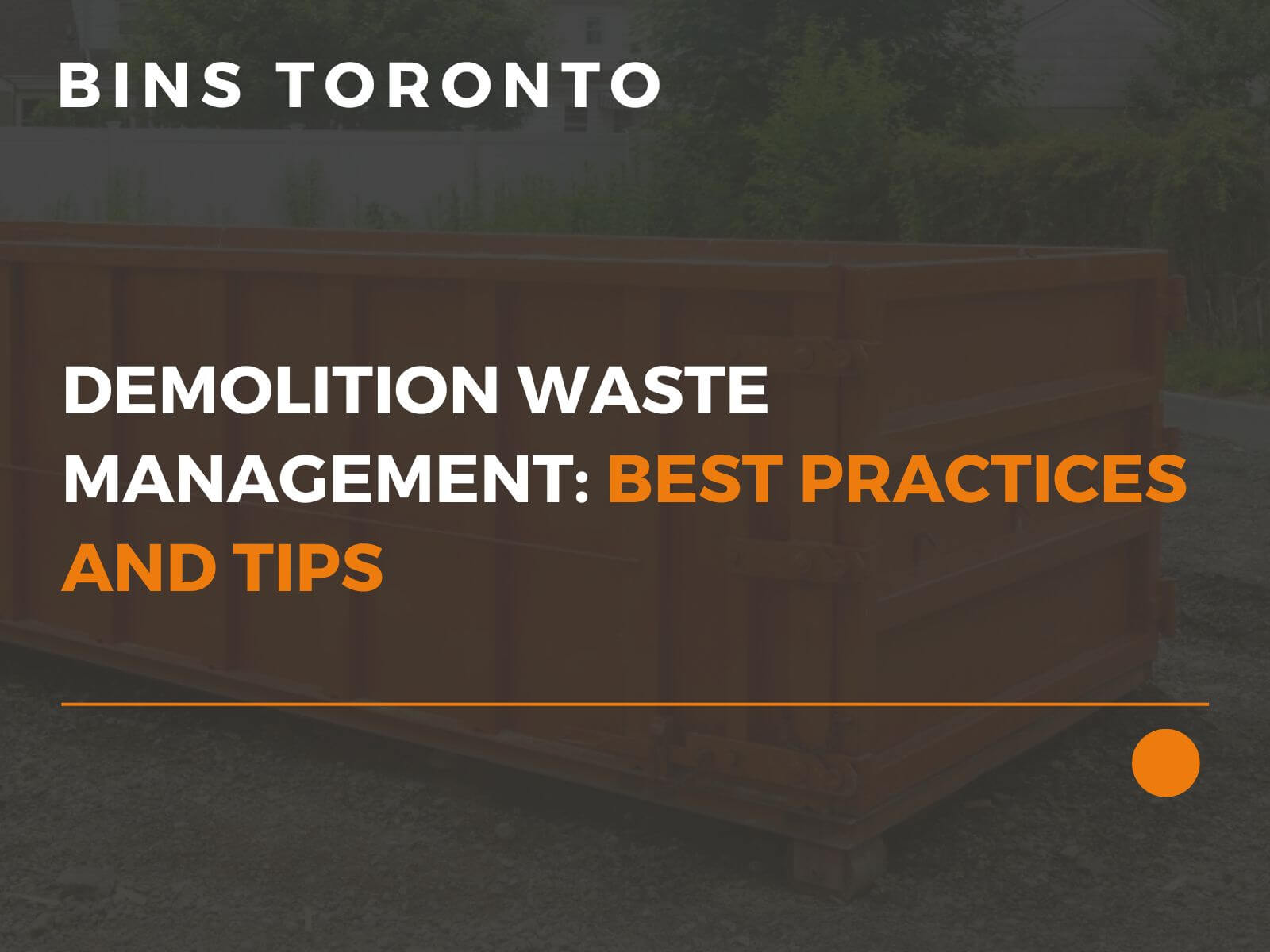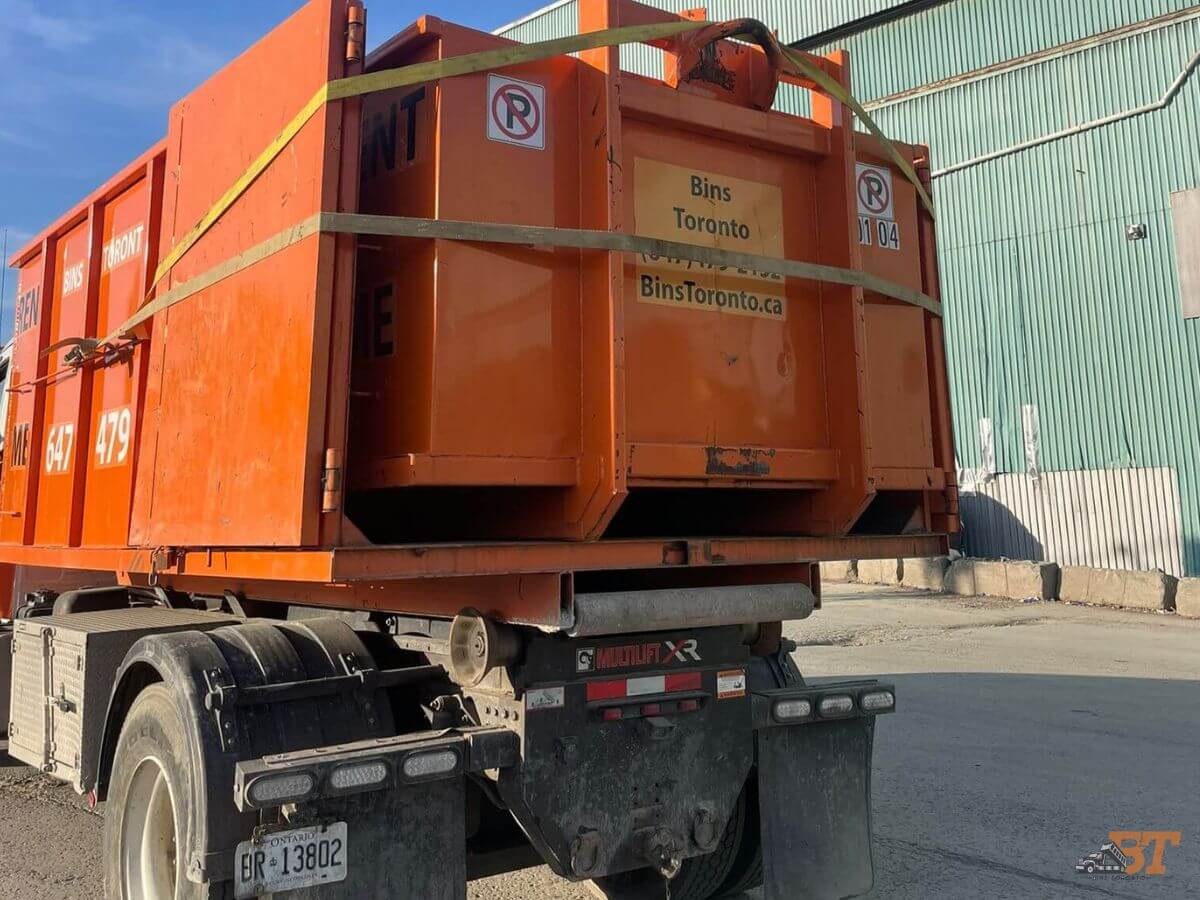

Premier Bin rental Service in Toronto and the GTA

January 16, 2024
Demolition activities are crucial to development projects, but they generate large volumes of waste that can seriously impact the environment if poorly managed. Proper demolition waste management is critical when renting a construction bin in Toronto ensuring sustainable environmental practices in Canada.
This blog will provide an overview of the best practices and tips for effectively managing demolition waste. It will cover everything from understanding what demolition waste is to proper waste disposal, with a focus on sustainable practices for a greener future.
Demolition waste refers to the debris and rubble generated during the demolition or dismantling of buildings and structures. Understanding the different types of waste is crucial for proper management and disposal to minimize environmental impact and optimize resource recovery.
The types of demolition waste can be broadly categorized into:
Concrete and Masonry: Debris from concrete, brick, stone, and other masonry materials.
Wood: Debris from wood, lumber, and other wooden products.
Metals: Debris from steel, aluminum, copper, and other metal products.
Asbestos and Other Hazardous Materials: Debris from materials containing asbestos, lead, and other hazardous substances.
Plastics and Other Non-Metallic Materials: Debris from plastic, rubber, insulation, and other non-metallic materials.
Other Miscellaneous Materials: Debris from other miscellaneous materials, including appliances, furniture, and fixtures.
It is essential to handle and dispose of all demolition waste properly and responsibly to avoid negative impacts on the environment and human health. The segregation and sorting of different types of waste is crucial to enable recycling and resource recovery efforts. Effective planning, execution, and monitoring throughout the process can help ensure optimal results.
Effective management of demolition waste involves complying with the legal framework surrounding its handling, transportation, and disposal. In Canada, various laws, regulations, and permits govern the management of demolition debris. The regulations cover different aspects of waste management, including environmental protection and public health. The compliance requirements may vary depending on the type and volume of waste generated.
One of the primary regulations governing demolition waste management is the Canadian Environmental Protection Act 1999, which establishes the legal framework for environmental protection in Canada. The act outlines the statutory requirements for the handling and disposal of hazardous waste, including demolition debris that contains toxic substances.
In addition to national regulations, each Canadian province and territory has specific regulations regarding demolition waste management. For instance, Ontario Regulation 153/04 requires waste generators to complete waste audits and implement waste management plans to reduce waste generation.
Furthermore, the transportation of demolition waste is subject to specific regulations. The Transportation of Dangerous Goods Act protects public safety by regulating the transportation of hazardous materials, including demolition waste with hazardous properties. The act mandates that the waste must be appropriately labelled, packaged, and transported following specific procedures and standards.
Demolition waste management plans must comply with the set regulations. These plans outline the strategies for managing and disposing of the waste, including recycling and minimizing waste generation. The plans must be submitted to the relevant regulatory authorities for approval before the start of the demolition project.
Effective planning is crucial in achieving efficient demolition waste management. Before commencing any demolition project, a thorough site assessment must be conducted to identify potential environmental risks and hazards. This assessment provides valuable information on the type and quantity of waste to be generated, enabling proper planning for its management.
Waste characterization is an essential step in planning efficient demolition waste management. The purpose of waste characterization is to identify the hazardous and non-hazardous components of the waste. By segregating the waste at the source, the materials can be disposed of or recycled appropriately, decreasing the amount of waste that ends up in landfills.
The waste characterization process is simplified by creating a waste management plan. This plan outlines the strategies and procedures for waste handling and disposal, ensuring compliance with all relevant regulations and laws. The waste management plan should include details about waste segregation, transportation, storage, and disposal.
A waste management plan helps identify the most efficient and cost-effective waste handling procedures and minimizes the risk of accidents. By considering all the factors in the planning process, waste disposal expenses can be reduced while minimizing the environmental impact of the demolition project.
To minimize the amount of waste generated during demolition projects, it is crucial to implement waste reduction and minimization strategies. These strategies can significantly reduce waste and conserve resources, leading to cost savings and an overall positive impact on the environment.
One effective strategy is deconstruction, which involves carefully taking apart a building to salvage materials for reuse. This enables materials such as lumber, doors, and windows to be repurposed instead of discarded as waste.
Another strategy is salvaging materials for resale or donation to charities, a win-win for both the environment and the community. This not only reduces the amount of waste sent to landfills but also provides affordable building materials.
Implementing waste reduction practices throughout the project can also help minimize waste. This can include reducing packaging materials, reusing materials on-site, and separating materials for recycling.
By implementing these strategies, the amount of waste generated during demolition projects can be significantly reduced. This not only benefits the environment but also offers cost savings and potential revenue streams through material recovery and reuse.

Proper segregation and sorting of demolition waste are crucial for effective waste management. By separating different types of waste, it becomes easier to recycle or dispose of them appropriately. Segregation involves separating the waste into different categories based on material type. Sorting entails removing any contaminants or impurities from the waste stream to produce high-quality recyclable material.
Benefits of segregation and sorting of demolition waste include:
Segregation of waste streams involves separating demolition waste into different categories based on the material type. This simplifies the management of waste streams by preventing the mixing of incompatible waste types. Segregation may include:
Sorting of waste streams involves removing contaminants from the waste stream to produce high-quality recyclable material. The sorting process can be manual or automated and may include:
Segregation and sorting of demolition waste are essential for effective waste management. It ensures that less waste ends up in landfills, increases recycling rates, and reduces waste disposal costs. Proper segregation and sorting of waste streams can simplify the management of waste, prevent contamination, and enable the recovery of high-quality recyclable material.
Recycling and reusing demolition waste is a critical aspect of sustainable waste management. Not only does it help to reduce the need for landfill space, but it can also help to conserve natural resources and reduce greenhouse gas emissions. There are various recycling technologies and methods available for processing demolition waste, including:
Reusing debris is also an essential part of waste management. Salvaging materials, such as wood, metal, and brick before demolition, and using them in new construction projects can help reduce costs and conserve resources. Additionally, recycling and reusing construction materials can lead to job creation and economic benefits. Bin rentals are another great aspect!
Effective demolition waste management is essential for minimizing the environmental impact of construction activities. By adopting best practices and following regulatory frameworks, construction companies, and contractors can ensure the safe and responsible handling, transportation, and disposal of demolition debris.
Planning and waste reduction strategies, such as segregation and sorting, recycling, and reuse, can significantly reduce the amount of waste that ends up in landfills. Additionally, sustainable practices and technological innovations can further optimize waste management processes and reduce environmental impact. Contact Bins Toronto to book a company to remove your junk today!